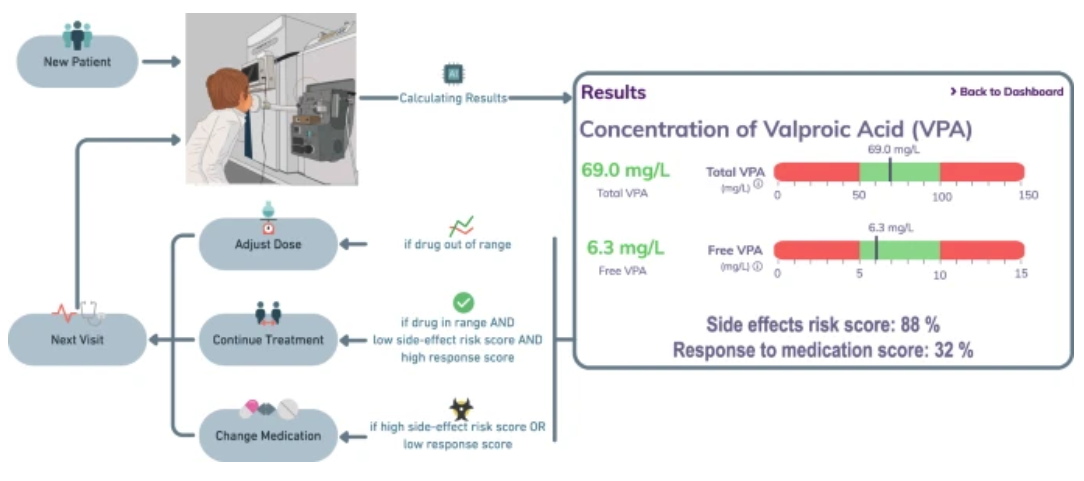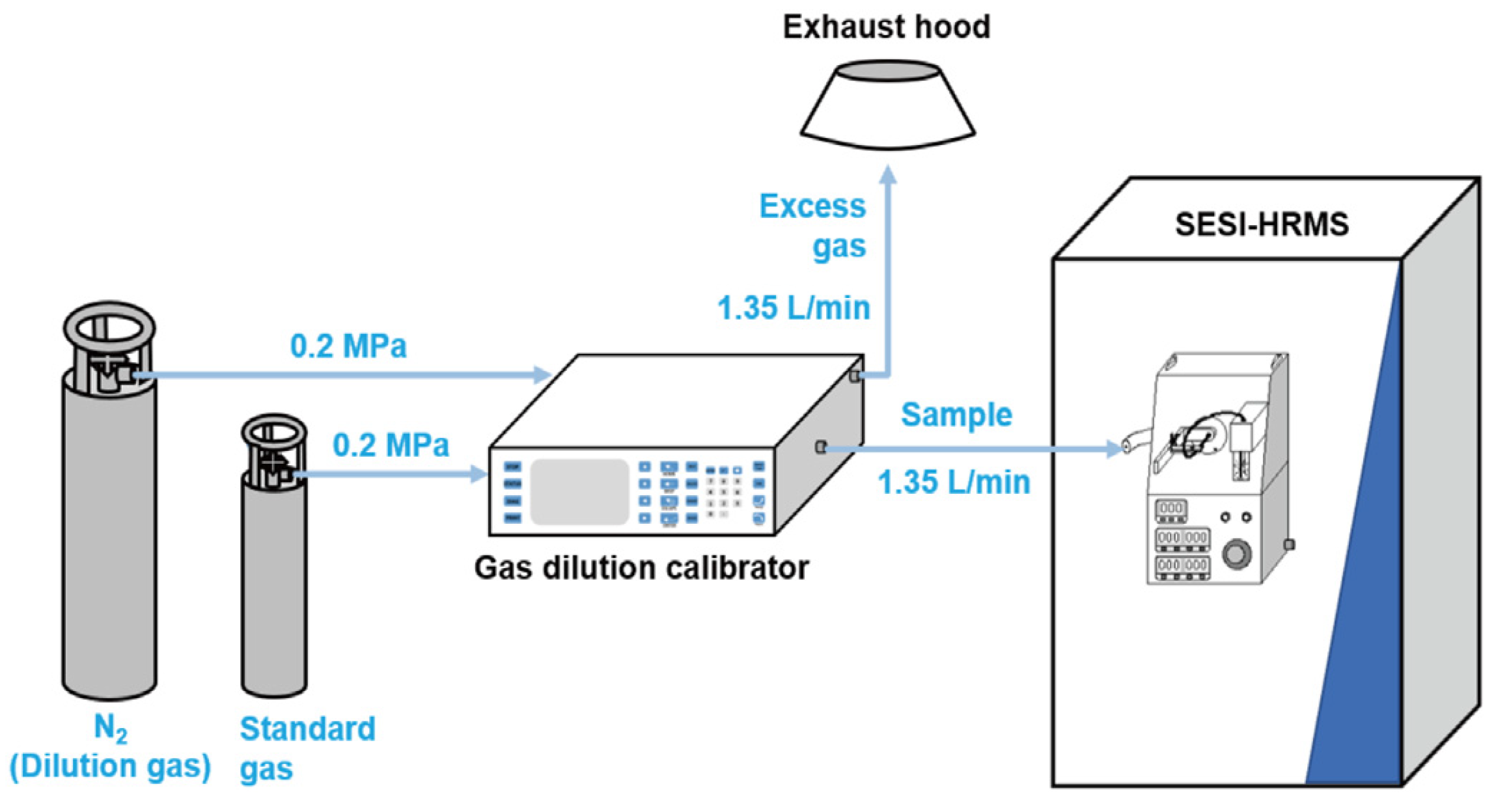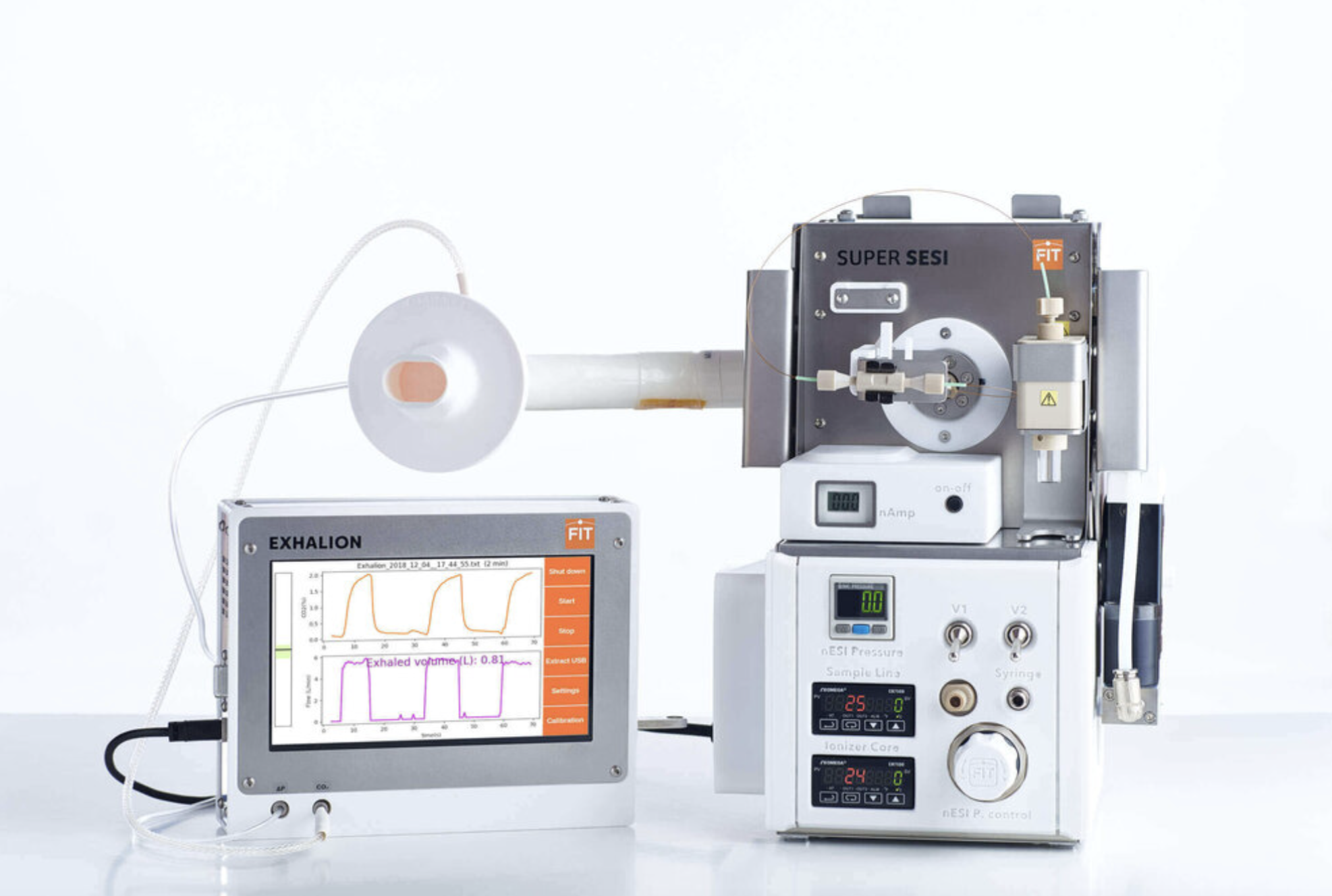Real-Time Monitoring of Metabolism during Exercise by Exhaled Breath
Jérôme Kaeslin, Srdjan Micic, Ronja Weber, Simona Müller, Nathan Perkins, Christoph Berger, Renato Zenobi, Tobias Bruderer, and Alexander Moeller
Continuous monitoring of metabolites in exhaled breath has recently been introduced as an advanced method to allow non-invasive real-time monitoring of metabolite shifts during rest and acute exercise bouts. The purpose of this study was to continuously measure metabolites in exhaled breath samples during a graded cycle ergometry cardiopulmonary exercise test (CPET), using secondary electrospray high resolution mass spectrometry (SESI-HRMS).We also sought to advance the research area of exercise metabolomics by comparing metabolite shifts in exhaled breath samples with recently published data on plasma metabolite shifts during CPET.
New Insights into Online Molecular Characterization of Organic Aerosol in China Using Extractive Electrospray Ionization and Ultrahigh Resolution Mass Spectrometry (EESI-Orbitrap)
Qi, Lu ; Lee Chuan, Ping ; Giannoukos, Stamatios ; Wang, Dongyu ; Li, Zhiyu ; Ran, Weikang ; Ye, Penglin ; Wang, Liwei ; Wang, Meng ; Lin, Yue ; Han, Yuemei ; Wang, Qiyuan ; Baltensperger, Urs ; El-Haddad, Imad ; Cao, Junji ; Prevot, Andre; Slowik, Jay
Despite extensive study, the sources and processes governing the formation and chemical evolution of haze pollution episodes in urban China remain unclear. Real-time molecular characterization of organic aerosol (OA) represents a promising approach to this problem. Extractive electrospray ionization (EESI) mass spectrometry allows real-time detection of individual OA components, while avoiding thermal decomposition and ionization-induced fragmentation. In previous field measurements, the EESI source was coupled with time-of-flight (TOF) mass analyzers, which are limited to a mass resolution of ~12,000 (at 200 m/z)…
Differentiation of Cystic Fibrosis-Related Pathogens by Volatile Organic Compound Analysis with Secondary Electrospray Ionization Mass Spectrometry
Jérôme Kaeslin, Srdjan Micic, Ronja Weber, Simona Müller, Nathan Perkins, Christoph Berger, Renato Zenobi, Tobias Bruderer, and Alexander Moeller
Identifying and differentiating bacteria based on their emitted volatile organic compounds (VOCs) opens vast opportunities for rapid diagnostics. Secondary electrospray ionization high-resolution mass spectrometry (SESI-HRMS) is an ideal technique for VOC-biomarker discovery because of its speed, sensitivity towards polar molecules and compound characterization possibilities. Here, an in vitro SESI-HRMS workflow to find biomarkers for cystic fibrosis (CF)-related pathogens P. aeruginosa, S. pneumoniae, S. aureus, H. influenzae, E. coli and S. maltophilia is described.
Secondary electrospray ionization-high resolution mass spectrometry (SESI-HRMS) fingerprinting enabled treatment monitoring of pulmonary carcinoma cells in real time
Fouad Choueirya, Jiangjiang Zhu
Lung cancer is one of the leading causes of cancer related deaths in the United States. A novel volatile analysis platform is needed to complement current diagnostic techniques and better elucidate chemical signatures of lung cancer and subsequent treatments. A systems biology bottom-up approach using cell culture volatilomics was employed to identify pathological volatile fingerprints of lung cancer in real time. An advanced secondary electrospray ionization (SESI) source, named SuperSESI was used in this study and directly attached to a Thermo Q-Exactive high-resolution mass spectrometer (HRMS).
Combination of exhaled breath analysis with parallel lung function and FeNO measurements in infants
Fabienne Decrue, Kapil Dev Singh, Amanda Gisler, Mo Awchi, Jiafa Zeng, Jakob Usemann, Urs Frey and Pablo Sinues
Breath analysis by secondary electrospray ionization-high resolution mass spectrometry (SESI-HRMS) offers the possibility to measure comprehensive metabolic profiles. The technology is currently being deployed in several clinical settings in Switzerland and China. However, patients are required to exhale directly into the device located in a dedicated room. Consequently, clinical implementation in patients incapable of performing necessary exhalation maneuvers (e.g., infants) or immobile (e.g., too weak, elderly, or in intensive care) remains a challenge. The aim of this study was to develop a method to extend such breath analysis capabilities to this subpopulation of patients by collecting breath samples remotely (offline) and promptly (within 10 min) transfer them to SESI-HRMS for chemical analysis.
Rapid and reversible control of human metabolism by individual sleep states
N.Nowak, T. Gaisl, D. Miladinovic, R. Marcinkevics, M. Osswald, S. Bauer, J. Buhmann, R. Zenobi, P. Sinues, S. A. Brown, M. Kohler
Using exhaled breath analysis by secondary high-resolution mass spectrometry, we measured the human exhaled metabolome at 10-s resolution across a night of sleep in combination with conventional polysomnography. Our subsequent analysis of almost 2,000 metabolite features demonstrates rapid, reversible control of major metabolic pathways by the individual vigilance states. A switch to wake reduces fatty acid oxidation, a switch to slow-wave sleep increases it, and the transition to rapid eye movement sleep results in elevation of tricarboxylic acid (TCA) cycle intermediates. Thus, in addition to daily regulation of metabolism, there exists a surprising and complex underlying orchestration across sleep and wake. Both likely play an important role in optimizing metabolic circuits for human performance and health.
Breath Analysis by Secondary Electro-Spray Ionization - Mass Spectrometry to Interrogate Biologically Significant Metabolites Non-Invasively
Francisco G. Blanco and Guillermo Vidal-de-Miguel
Here, we review the SESI technology development, the different SESI configurations developed, and the standardization procedures described to translate SESI into the clinical environment. Finally, SESI main applications described in the literature with prompt translation into the clinical environment, namely, biomarker discovery or pharmacokinetics and drug monitoring are revised.
Sensitivity of SESI-MS to a range of volatile organic compounds: ligand switching ion chemistry and the influence of Zspray™ guiding E-fields
Kseniya Dryahina, Miroslav Polášek, David Smith, Patrik Španěl
Secondary electrospray ionization (SESI) is currently only semi-quantitative. In the Zspray™ arrangement of SESI-MS, the transfer of ions from near atmospheric pressure to a triple quadrupole is achieved by guiding E-fields that partially desolvate both reagent and analyte ions which must be understood.
Personalised therapeutic management of epileptic patients guided by pathway-driven breath metabolomics
Kapil Dev Singh, Martin Osswald, Victoria C. Ziesenitz, Mo Awchi, Jakob Usemann, Lukas L. Imbach, Malcolm Kohler, Diego García-Gómez, Johannes van den Anker, Urs Frey, Alexandre N. Datta & Pablo Sinues
Therapeutic management of epilepsy remains a challenge, since optimal systemic antiseizure medication (ASM) concentrations do not always correlate with improved clinical outcome and minimal side effects. We tested the feasibility of noninvasive real-time breath metabolomics as an extension of traditional therapeutic drug monitoring for patient stratification by simultaneously monitoring drug-related and drug-modulated metabolites.
Quantification of volatile organic compounds by secondary electrospray ionization-high resolution mass spectrometry
Chao Liu, Jiafa Zeng, Pablo Sinues, Mingliang Fang, Zhen Zhou, Xue Li.
SESI-HRMS has been successfully applied in multiple applications, including breath analysis, animals and plants VOCs emissions, analysis of headspace of cell cultures and indoor and outdoor air. In this study we aim to develop a quantitative method for eight representative VOCs, including ketones (acetone, 2-butanone and 2-pentanone), alkenes (isoprene and α-terpinene) and aromatics (toluene, styrene and mesitylene).
Real-time (on-line) chemical characterisation of thermal aerosols by super secondary electrospray ionization coupled with high-resolution mass spectrometry (Super SESI-HRMS)
T. Živković Semren, S. Majeed, M. Fatarova, C. Laszlo, C. Pak, S. Steiner, A. Kuczaj, A. Mazurov, M. Peitsch, N. Ivanov, J. Hoeng, and P. A. Guy
We used a programmable dual syringe pump (PDSP) connected to a super secondary electrospray ionisation (SESI) system interfaced with a Q Exactive HF mass spectrometer (MS) to detect the main constituents of thermally generated aerosols in real time. The benefits of Super SESI–HRMS for detecting drug aerosolisation from variably prepared in-house formulations with anatabine, azithromycin, chloroquine, favipiravir, and hydroxychloroquine were evaluated.
High-frequency gaseous and particulate chemical characterization using extractive electrospray ionization mass spectrometry (Dual-Phase-EESI-TOF)
Chuan Ping Lee, Mihnea Surdu, David M. Bell, Josef Dommen, Mao Xiao, Xueqin Zhou, Andrea Baccarini, Stamatios Giannoukos, Günther Wehrle, Pascal André Schneider, Andre S. H. Prevot, Jay G. Slowik, Houssni Lamkaddam, Dongyu Wang, Urs Baltensperger, and Imad El Haddad
To elucidate the sources and chemical reaction pathways of organic vapors and particulate matter in the ambient atmosphere, real-time detection of both the gas and particle phase is needed. State-of-the-art techniques often suffer from thermal decomposition, ionization-induced fragmentation, high cut-off size of aerosols or low time resolution. In response to all these limitations, we developed a new technique that uses extractive electrospray ionization (EESI) for online gas and particle chemical speciation, namely the dual-phase extractive electrospray ionization time-of-flight mass spectrometer (Dual-Phase-EESI-TOF or Dual-EESI for short)….
Metabolic Insights Related to Sleep and Circadian Clocks from Mass Spectrometry-Based Analysis of Blood and Breath
Nora Kristina Nowak
Most physiological processes in humans are synchronized with their environment by socalled circadian clocks. These molecular time-keeping machineries are present in almost every cell. While light is the most important external stimulus to reset the circadian clocks, they can also be entrained by other stimuli, such as feeding or rest/activity cycles. Sleep is both, one of the major outputs of circadian clocks and also an independently regulated recuperative neurobiological process.
In vivo monitoring of volatile metabolic trajectories enables rapid diagnosis of influenza A infection
Zhihong Yin, Wenbo Huang, Kapil Dev Singh, Zhaoming Chen, Xing Chen, Zhen Zhou, Zifeng Yang, Pablo Sinues and Xue Li
We report that influenza A virus infection induces changes in odor traits that could be captured by real-time high-resolution mass spectrometry in a living mouse model. The most striking changes in the volatile metabolites may be associated mostly to glyoxylate/dicarboxylate metabolism.
Validation of breath biomarkers for obstructive sleep apnea
Nora Nowak, Anna Engler, Sira Thiel, Anna S. Stöberl, Pablo Sinues, Renato Zenobi, Malcolm Kohler
Here, we could confirm significant differences between metabolic patterns in exhaled breath from OSA patients compared to control subjects without OSA as well as the association of breath biomarker levels with disease severity. Our prediction of the diagnosis for the patients from this completely independent validation study using a classification model trained on the data from the previous study resulted in an area under the receiver operating characteristic curve of 0.66, which is comparable to questionnaire-based OSA screenings.
Online Real-Time Monitoring of Exhaled Breath Particles Reveals Unnoticed Transport of Nonvolatile Drugs from Blood to Breath
Xing Chen, Keda Zhang, Zhihong Yin, Mingliang Fang, Weidan Pu, Zhening Liu, Lei Li, Pablo Sinues, Robert Dallmann, Zhen Zhou and Xue Li
This study advances our knowledge on the mechanism by which nonvolatile drugs are transferred from blood into exhaled breath, providing guidance for breath test-based therapeutic drug monitoring.
Minimizing ion competition boosts volatile metabolome analysis by secondary electrospray ionization orbitrap mass spectrometry
Jiayi Lan, Jérôme Kaeslin, Giorgia Greter, Renato Zenobi
Here, we show that besides ion suppression, ion competition in the C-trap of Orbitrap instruments is another important factor that influences sensitivity and reproducibility of SESI-MS. Instead of acquiring the full mass-to-charge ratio (m/z) range, acquisition of consecutive m/z windows to minimize the ion competition effect allows the detection of more features.
Insights on the Working Principles of Secondary ElectrosprayIonization High‑Resolution Mass Spectrometry for QuantitativeAnalysis of Aerosol Chemical Composition
Xin Xu, · Jia Fa Zeng, · Dan Dan Jin,· Zheng Xu Huang, · Lei Li,·Anthony S. Wexler, · Man Nin Chan, ·Zhen Zhou, · Yong Jie Li and Xue Li
we demonstrated the working principles of secondary nanoelectrospray ionization (Sec-nESI) for real-time measurement of laboratory-generated organic aerosols using l-tartaric acid (TA) as a model compound. Factors affecting the detection of TA particles using a homemade Sec-nESI source coupled with a high-resolution mass spectrometer are systematically investigated.
Detection of trace metals in biogas using extractive electrospray ionization high-resolution mass spectrometry
Stamatios Giannoukos, Mohamed Tarik, Christian Ludwig, Serge Biollaz, Jay Slowik, Urs Baltensperger, Andre Stephan Henry Prevot
On-line measurements of metal emissions in energy conversion systems at very low concentrations are difficult to perform using existing techniques. Metals are of high importance due to their detrimental impact on human health, the environment and various industrial processes and/or equipment. Herewith and for the first time, we report the real-time detection and characterization of metals and trace elements in a Swiss biogas production plant using a novel technology based on an extractive electrospray ionization (EESI) source coupled to a high-resolution time-of-flight mass spectrometer (TOF-MS)…




















